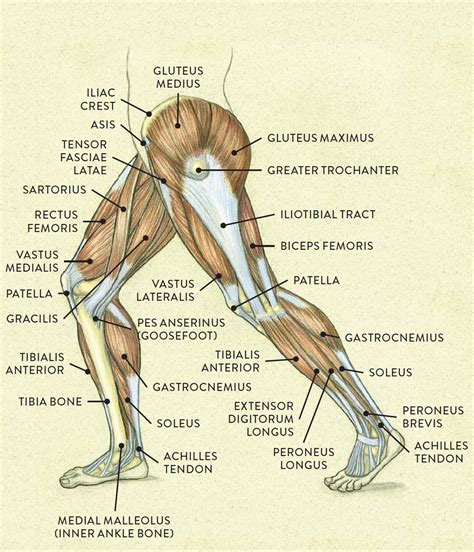In the world of athletics, strong leg tendons are gold, aren’t they? Unfortunately, they often tell us what they think of our training choices by becoming stiff, tender structures. When they do that, our favorite sport may seem as far away as the moon.
Stiff, tight leg muscles don’t just affect our sports performance. They’re also a huge factor in our sedentary lifestyles. It may not be surprising that modern man’s most common complaint is lower back pain. When leg tendons shorten, they pull the pelvis forward, arching the lower back. That places extra pressure on the lumbar region. But that’s not all. Shortened leg tendons can also cause knee, hip, and foot problems.
There are two important leg tendons which are your hamstrings and your quadriceps. Your hamstrings are found on the back of your upper leg and run along your knee. Your quadriceps are on the front of your upper leg and run along your knee. Another significant group of muscles that plays a role in leg stability is your calf muscles, which help with foot and leg movement.
From this article, you’ve learned that leg tendons are vital for many movements. They can be injured through overexertion or undertraining, They are also vulnerable to injury if they are weak and not flexible. Whether you’re an elite level competitor or a weekend sports enthusiast, it’s important to understand leg tendons and how to keep them healthy.
Leg Tendons: The Unsung Heroes of Movement
https://tse1.mm.bing.net/th?q=leg+tendons
The human body is a remarkable machine, capable of intricate and dynamic movements. Behind this impressive feat lies a network of tendons, resilient and fibrous cords that connect muscles to bones. Among these crucial tendons, the leg tendons play a pivotal role in our ability to walk, run, jump, and perform countless other activities.
The Anatomy of Leg Tendons
The leg tendons, also known as the hamstring tendons, are located at the back of the thigh. They comprise three distinct muscles: the semitendinosus, the semimembranosus, and the biceps femoris. These muscles originate from the pelvis and insert into the tibia and fibula bones of the lower leg.

The Function of Leg Tendons
The primary function of leg tendons is to transmit the force generated by the hamstring muscles to the bones, enabling knee flexion and hip extension. This coordinated action is essential for walking, running, jumping, and maintaining balance.
The Role of Leg Tendons in Sports
In sports that demand explosive movements, such as sprinting, jumping, and kicking, the leg tendons play a crucial role in generating power and speed. They act as powerful springs, storing and releasing energy during rapid muscle contractions. This elastic recoil propels the body forward or upward, enhancing athletic performance.

Leg Tendon Injuries: Causes and Symptoms
Leg tendon injuries are common among athletes and individuals who engage in strenuous physical activities. These injuries can range from mild strains to complete ruptures. The most common causes of leg tendon injuries include:
- Sudden forceful contractions of the hamstring muscles
- Overuse and repetitive stress
- Poor flexibility and muscle imbalances
- Direct trauma to the leg
Symptoms of leg tendon injuries may include:
- Pain and tenderness at the back of the thigh
- Difficulty walking or running
- Swelling and bruising
- Inability to fully straighten or bend the knee
Treatment and Prevention of Leg Tendon Injuries
The treatment of leg tendon injuries depends on the severity of the injury. Mild strains may respond to rest, ice, compression, and elevation (RICE). More severe injuries may require physical therapy, corticosteroid injections, or even surgery.
Preventing leg tendon injuries involves:
- Warming up properly before exercise
- Gradually increasing the intensity and duration of exercise
- Maintaining flexibility and muscle balance
- Using proper technique during exercise
- Avoiding overtraining
Leg Tendons and Overall Health
Beyond their role in movement and sports performance, leg tendons contribute to overall health and well-being. They help maintain good posture, stabilize the knee joint, and protect the spine from excessive stress.

Leg Tendons: A Vital Component of Human Movement
The leg tendons are remarkable structures that play a vital role in our ability to move, perform sports, and maintain overall health. Understanding their anatomy, function, and potential injuries can help us appreciate their significance and take steps to protect them.
Additional Information
- The leg tendons are also known as the ischiocrural muscles.
- The semitendinosus tendon is the longest of the three hamstring tendons.
- The biceps femoris tendon is the strongest of the three hamstring tendons.
- Leg tendon injuries are more common in men than in women.
- The risk of leg tendon injuries increases with age.
- Leg tendon injuries can be prevented by warming up properly before exercise, gradually increasing the intensity and duration of exercise, maintaining flexibility and muscle balance, using proper technique during exercise, and avoiding overtraining.